Beauty Beyond the Eye of the Beholder – Punu Mukudj Masks
PRIMITIVE - Friday, March 27, 2015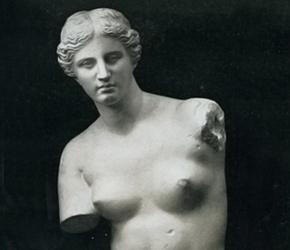 |
|
By Misaki Imagawa
What constitutes idealized feminine beauty? The answer changes based on who is doing the answering and the year the answer is taking place; but if you really want to answer the question you need only refer to artwork of the period. For example, in many early civilizations a beautiful woman was considered one who had a generous full figure. She was curvy, had wide hips and large breasts. In Ancient Egypt, women were depicted as being slender with high waists. They were portrayed as elegant, yet powerful, as beauties befitting lofty, important positions. During the Renaissance, desirable women were depicted as round, plump and pale; while in the Victorian Era, women needed to cinch their waists with impossibly tight corsets to meet different standards of beauty. Even in the last 100 years, ‘beauty’ has changed from the boyish, curve-less style of the 20s, to the hourglass figure of the 30s to 50s; then came the tall and thin 60s, the athletic supermodels of the 80s, the underweight beauties of the 90s, and finally, the slender-but-healthy, curvy-but-flat stomach beauty of the 2000s. The ideal of feminine beauty will undoubtedly change again and we will only need to look at the art being created to see where it has gone.
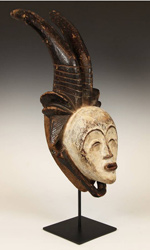 |
|
of Gabon, Central Africa; PRIMITIVE ID# A1500-054 |
There are iconic artworks such as the Mona Lisa and Venus de Milo that have been praised for epitomizing timeless female beauty. Invariably, works of this sort incorporate elements of serene expressions, enigmatic facial features and pleasing proportions – all physical attributes. In other words, much of the focus in western art is found in the physical beauty of the subject and the close resemblance they bear to real life figures; yet elsewhere in the world cultures create art idealizing women’s physical and spiritual qualities. This is the case with many African cultures; and among them the Punu people of Gabon are particularly renowned for their unique masks idealizing feminine beauty.
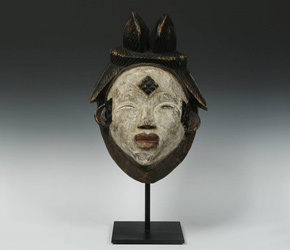 |
|
PRIMITIVE ID# A1200-424 |
Distinct white masks of the Punu people are called mukudj, although they have also been called other names depending on the region where they were carved. The mukudj can only be carved by a master craftsman who has gone through special initiation rites within the men’s secret society called mwiri. Presumably, the carver’s initiation puts them in touch with the exact qualities they must incorporate into the mask. Every detail of the mask, from the round gentle curves to the elaborate coiffure, arched eyebrows, high cheekbones, full sensuous lips, and white color is meant to reflect a woman’s physical and spiritual perfection. It is the white color – the color the Punu associate with their ancestors and the afterlife – that gives the mask a dimension extending beyond physical beauty alone. The Punu believe ideal feminine beauty is as much a matter of what can’t be seen as opposed to what can; and nothing exemplifies this more than the mukudj mask. It not only represents a beautiful woman, but their ancestor spirits. The mask is nothing less than an intermediary between the living and the dead.
What make the mukudj truly memorable are its symbolic elements. The thin slit eyes are meant to express a meditative serenity suggesting inner vision and a link to the world of the ancestors. The white color, derived from kaolin, is associated with the afterlife and spirits of the dead. Consequently, the mask is featured in funeral rites. The scarification marks on the forehead and temples are not just aesthetic marks of sensual beauty. They also contain spiritual significance. The mark is believed by some to represent the nine original clans in Punu creation myths and their various migration paths, which led to the widespread dispersal and use of the mukudj among the Punu as well as other tribes of the region.
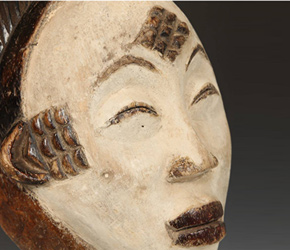 |
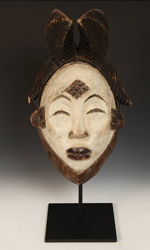 |
||
PRIMITIVE ID# A1500-051 |
|||
The mukudj is worn and danced in an elaborate ceremony involving a skilled dancer standing on stilts that can reach 6 to 10 feet tall. The dancer is trained from childhood and must be initiated in the mwiri. They’re covered head to toe to keep their identity secret; which is an important feature of the mask’s use because it represents an entity greater than the living. The extreme, elevated height of the mask is a direct reference to the mukudj’s power and farsighted vision – the power and vision of the ancestors – and the height at which the mask is danced can be interpreted as the ancestors watching over the living. Although the mukudj mask is closely linked with the afterworld, it is by no means exclusive to funeral rites or solemn occasions. They are also danced for important celebrations such as significant birthdays and childbirth.
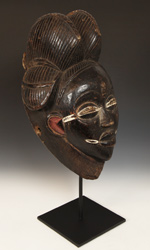 |
|
PRIMITIVE ID# NC1407-003 |
In contrast to the white mukudj, there also exist black masks. Much less is known about this type of mukudj. Unlike the white masks, black mukudj are associated with evil spirits and witchcraft. Traditionally used for judgments, the black masks are danced at twilight or night on stilts considerably shorter than those used for the white mukudj. While the white masks are celebrated as ancestors returning to protect the people, the black masks are considered dangerous and ominous.
The mukudj are visual representations of what can and cannot be seen. The creation of this mask represents a different point of view than the western concept of realism. In traditional African art, creating exact likenesses is not seen as a complete representation of ‘beauty.’ There is no such thing as lifelike art with striking realism. In short, in traditional African art there is no Mona Lisa. Instead, emphasis is placed on the unseen aspects present in true female beauty. While this may release a figure from having perfect physical proportions, it elevates spiritual relevance to a point far beyond most western works. In the eyes of the Punu people, beauty is more than just curvy hips or athletic bodies. Beauty is represented by inner qualities that we cannot always see. In a sense then, the mukudj is like a third eye giving us the ability to perceive true beauty beyond the physical.
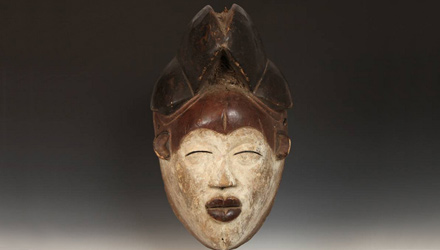 |
Download this Article: Beauty Beyond the Eye of the Beholder.pdf